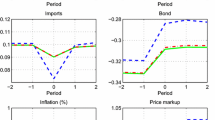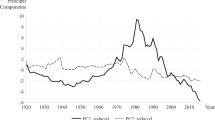Abstract
To estimate how monetary policy works in small open economies, we build a dynamic stochastic general equilibrium model that incorporates the basic features of these economies. We conclude that the monetary policy in a group of small open economies (including Australia, Chile, Colombia, Peru, and New Zealand) is rather similar to that observed in closed economies. Our results also indicate, however, that there are strong differences due to the shocks from the international financial markets (mainly risk premium shocks). These differences explain most of the variability of the real exchange rate, which has important reallocation effects in the short run. Our results are consistent with an old idea from the Mundell–Fleming model: namely, a real depreciation to confront a risk premium shock is expansive or procyclical, in contradiction to the predictions of the balance sheet effect, the J curve effect, and the introduction of working capital into RBC models. In line with this last result, we have strong evidence that only in one of the five countries analyzed in this study does not intervene the real exchange rate, the case of New Zealand.













Similar content being viewed by others
Notes
Several authors build DSGE models to analyze macroeconomic policies in open economies. Those using Bayesian estimation techniques include Adolfson et al. (2007), Castillo et al. (2006), Caputo et al. (2006), Cook (2004), Devereux et al. (2006), Elekdag et al. (2006), García et al. (2011a, b), García and Gonzalez (2013), Hamann et al. (2006), Medina and Soto (2007), and Tovar (2006).
The real exchange rate is obtained from Eq. (2) using the following transformation of the external debt in domestic real terms: \(S_t B_t^{{\mathrm{o}}^*} /P_t =b_t^{{\mathrm{o}}*} \) and
$$\begin{aligned}&S_t \left\{ {\Phi \left( {\frac{b_{t+1}^{{\mathrm{o}}^*} }{{\mathrm{GDP}}_t },\frac{b_{t+1}^{{\mathrm{o}}^*} }{Q_t K_{t+1} },u_t^{RK} } \right) R_t^*} \right\} ^{-1}B_{t+1}^{{\mathrm{o}}^*} (i)\\&\quad =\left( {Q_t^*/Q_{t+1}^*} \right) \left\{ {\Phi \left( {\frac{b_{t+1}^{{\mathrm{o}}^*} }{{\mathrm{GDP}}_t },\frac{b_{t+1}^{{\mathrm{o}}^*} }{Q_t K_{t+1} },u_t^{RK} } \right) R_t^*} \right\} ^{-1}\left( {P_{t+1}^*/P_t^*} \right) b_{t+1}^{{\mathrm{o}}^*} (i). \end{aligned}$$The first-order condition for utility maximization is obtained with respect to \(b_{t+1}^{{\mathrm{o}}^*} \left( i \right) \).
See Schmitt-Grohé and Uribe (2003).
Céspedes et al. (2004), following Bernanke et al. (1999), assume that the risk premium is given by:
$$\begin{aligned} 1+\eta _{t+1} =F\left( {\frac{{\mathop {Q_{t}}\limits ^{\smile }}K_{t+1} }{\mathop {Q_{t}}\limits ^{\smile }K_{t+1}-S_t B_{t+1}^*}} \right) =G\left( {\frac{{S_t B_{t+1}^*}}{\mathop {Q_{t}}\limits ^{\smile }K_{t+1} }}\right) \qquad \quad F\left( 1 \right) =1,\,\,F^{\prime }>0,\,\, Q=\frac{\mathop {Q_{t}}\limits ^{\smile }}{P} \end{aligned}$$We assume that the risk premium can be represented by a similar function to characterize the balance sheet effect:
$$\begin{aligned} 1+\eta _{t+1} =\Phi \left( {\frac{b_{t+1}^{{\mathrm{o}}^*} }{{\mathrm{GDP}}_t },\frac{b_{t+1}^{{\mathrm{o}}^*} }{Q_t K_{t+1} },u_t^{RK} } \right) ,\quad \quad b_{t+1}^{{\mathrm{o}}^*} =\frac{S_{t+1} B_{t+1}^{{\mathrm{o}}^*} }{P_{t+1} }. \end{aligned}$$\(b_{t+1}^{{\mathrm{o}}^*} =\frac{S_{t+1} B_t^{{\mathrm{o}}^*} }{P_{t+1} }=\frac{S_{t+1} B_t^{{\mathrm{o}}^*} }{P_{t+1} }\frac{P_{t+1}^*}{P_{t+1}^*}={\mathrm{real}}\;{\mathrm{exchange}}\;{\mathrm{rate}}\times \frac{B_{t+1}^{{\mathrm{o}}^*} }{P_{t+1}^*}\quad \)
This approach similar to Laxton and Pesenti (2003).
We are aware that the GDP with natural resource will be in our model this expression: \({\mathrm{GDP}}_t =P_t^D Y_t^D -S_t P_t^*I_t +(S_t P_t^{cu} Q\_c)\), but we consider that the relevant concept for monetary policy is the definition of Eq. (36).
All this information (code and steady state) is available on request.
The details of the estimation of all parameters can be requested to the authors by email.
The real wage elasticity in the labor supply was calibrated; we chose a value for this parameter of 0.75 (Chetty et al. 2011).
To interpret the Bayes factor in comparing two models, we follow to Kass and Raftery (1995). So, if M1 is the model with the largest marginal likelihood, then there is positive evidence against model M0 if \(2^{*}\ln (Bayes\,factor\,between\,M1\,and\,M0)\) is large than six, strong evidence if this expression is larger than six, and definitive if it is larger than ten (page 789). This value is arbitrary in the same sense as a significance level of \(\upalpha \) = 0.05 is arbitrary in classical statistics, but, just like this value of \(\upalpha \), these categories seem to give an appropriate rule.
Studies that report a GDP contraction is in the first period all include working capital in the model. Thus, more expensive working capital should have a negative effect on output.
References
Adjemian S, Darracq-Pariès M, Moyen S (2008) Towards a monetary policy evaluation framework. Working paper 942. European Central Bank, Frankfurt
Adolfson M, Laséen S, Lindé J, Villani M (2008) Evaluating an estimated new Keynesian small open economy model. J Econ Dyn Control 32(8):2690–2721
Adolfson M, Stefan L, Jesper L, Villani M (2007) Bayesian estimation of an open economy DSGE model with incomplete pass-through. J Int Econ 72(2):481–511
Agénor PR, Montiel P (1996) Development macroeconomics. Princeton University Press, Princeton
Aghion P, Bacchetta P, Banerjee A (2004) A corporate balance-sheet approach to currency crises. J Econ Theory 119(1):6–30
Bahmani-Oskooee M, Ratha A (2004) The J-curve: a literature review. Appl Econ 36(13):1377–1398
Ball L (1999) Policy rules in open economies. In: Taylor JB (ed) Monetary policy rules. University of Chicago Press, Chicago, pp 127–156
Batini N, Harrison R, Millard SP (2003) Monetary policy rules for an open economy. J Econ Dyn Control 27(11–12):2059–2094
Bernanke B, Gertler M, Gilchrist S (1999) The financial accelerator in a quantitative business cycle framework. In Taylor JB, Woodford M (eds) Handbook of macroeconomics, vol. 1C. Amsterdam, Elsevier Science, North-Holland, pp 253–257
Bergin PR, Shin HC, Tchakarov I (2007) Does exchange rate variability matter for welfare? A quantitative investigation of stabilization policies. Eur Econ Rev 51(4):1041–1058
Calvo GA (1983) Staggered prices in a utility-maximizing framework. J Monet Econ 12(3):383–398
Calvo GA, Reinhart C (2002) Fear of floating. Q J Econ 117(2):379–408
Canova F (2007) Methods for applied macroeconomic research. Princeton University Press, Princeton
Caputo R, Liendo F, Medina JP (2006) Keynesian models for Chile during the inflation targeting regime: a structural approach. Working paper 402. Central Bank of Chile, Santiago
Castillo P, Montoro C, Tuesta V (2006) An estimated stochastic general equilibrium model with partial dollarization: a Bayesian approach. Working paper 381. Central Bank of Chile, Santiago
Cavoli T (2009) Is fear of floating justified? The East Asia experience. J Policy Model 31(1):1–16
Céspedes LF, Chang R, Velasco A (2004) Balance sheets and exchange rate policy. Am Econ Rev 94(4):1183–1193
Chetty R, Guren A, Manoli D, Weber A (2011) Are micro and macro labor supply elasticities consistent? A review of evidence on the intensive and extensive margins. Am Econ Rev Papers Proc 101:471–475
Christiano LJ, Eichenbaum M, Evans CL (2005) Nominal rigidities and the dynamic effects of a shock to monetary policy. J Political Econ 113(1):1–45
Clarida R, Galí J, Gertler M (1999) The science of monetary policy: a new Keynesian perspective. J Econ Lit 37(4):1661–1707
Clarida R, Galí J, Gertler M (2002) A simple framework for international monetary policy analysis. J Monet Econ 49(5):879–904
Colacelli M (2008) Export responses to real exchange rate fluctuations: development status and exported good effects. Columbia University, New York
Cook D (2004) Monetary policy in emerging markets: can liability dollarization explain contractionary devaluations? J Monet Econ 51(6):1155–1181
Del Negro M, Schorfheide F (2004) Priors from general equilibrium models for VARS. Int Econ Rev 45(2):643–673
Del Negro M, Schorfheide F, Smets F, Wouters R (2007) On the fit of new Keynesian models. J Bus Econ Stat 25:123–143
Devereux M, Lane P, Xu J (2006) Exchange rates and monetary policy in emerging market economies. Econ J 116(511):478–506
Elekdag S, Justiniano A, Tchakarov I (2006) An estimated small open economy model of the financial accelerator. IMF Staff Papers 53(2):2
Erceg CJ, Henderson DW, Levin AT (2000) Optimal monetary policy with staggered wage and price contracts. J Monet Econ 46(2):281–313
Galí J, López-Salido JD, Vallés J (2007) Understanding the effects of government spending on consumption. J Eur Econ Assoc 5(1):227–270
Galí J, Monacelli T (2005) Monetary policy and exchange rate volatility in a small open economy. Rev Econ Stud 72(3):707–734
Galí J, Rabanal P (2004) Technology shocks and aggregate fluctuations: How well does the RBS model fit postwar U.S. data? Working paper 10636. National Bureau of Economic Research, Cambridge
García CJ, Gonzalez W (2013) Exchange rate intervention in small open economies: the role of risk premium and commodity price shocks. Int Rev Econ Financ 25:424–447
García CJ, Restrepo J, Roger S (2011a) How much should inflation targeters care about the exchange rate? J Int Money Financ 30(7):1590–1617
García CJ, Restrepo J, Tanner E (2011b) Fiscal rules in a volatile world: a welfare-based approach. J Policy Model 33(4):649–676
Gertler M, Gilchrist S, Natalucci F (2007) External constraints on monetary policy and the financial accelerator. J Money Credit Bank 39(2–3):295–330
Hamann F, Pérez J, Rodríguez D (2006) Bringing a DSGE model into policy environment in Colombia. Banco de la Republica de Colombia, Bogotá
Imbs J, Méjean I (2010) Trade elasticities. A final report for the European commission, Economic Paper 432. European Commission
Kass RE, Raftery AE (1995) Bayes factors. J Am Stat Assoc 90:773–795
Krugman P (1999) Balance sheets, the transfer problem, and financial crises. Int Tax Public Financ 6(4):459–472
Laxton D, Pesenti P (2003) Monetary rules for small, open, emerging economies. J Monet Econ 50(5): 1109–1146
Levy-Yeyati E (2006) Financial dollarization: evaluating the consequences. Econ Policy 21(45):61–118
Lubik TA, Schorfheide F (2007) Do central banks respond to exchange rate movements? A structural investigation. J Monet Econ 54(4):1069–1087
Mankiw NG (2000) The savers-spenders theory of Fiscal policy. Am Econ Rev 90(2):120–125
McCallum B, Nelson E (2000) Monetary policy for an open economy: an alternative framework with optimizing agents and sticky prices. Oxf Rev Econ Policy 16(4):74–91
Medina J, Soto C (2007) The Chilean business cycle through the lens of a stochastic general equilibrium model, Working paper 457. Central Bank of Chile, Santiago
Morón E, Winkelried D (2005) Monetary policy rules for financially vulnerable economies. J Dev Econ 76(1):23–51
Neumeyer A, Perri F (2005) Business cycles in emerging economies: the role of interest rates. J Monet Econ 52(2):345–380
Schmitt-Grohé S, Uribe M (2003) Closing small open economy models. J Int Econ 61(1):163–185
Smets F, Wouters R (2002) Openness, imperfect exchange rate pass-through, and monetary policy. J Monet Econ 49(5):947–981
Smets F, Wouters R (2007) Shocks and frictions in U.S. business cycles: a Bayesian DSGE approach. Am Econ Rev 97(3):586–606
Svensson LEO (2000) Open-economy inflation targeting. J Int Econ 50(1):155–183
Tovar C (2006) An analysis of devaluations and output dynamics in Latin America using an estimated DSGE model. Bank for International Settlements, Basel
Uribe M, Yue VZ (2006) Country spreads and emerging countries: Who drives whom? J Int Econ 69(1):6–36
Wollmershauser T (2006) Should central banks react to exchange rate movements? An analysis of the robustness of simple policy rules under exchange rate uncertainty. J Macroecon 28(3):493–519
Woodford M (2003) Interest and prices: foundations of a theory of monetary policy. Princeton University Press, Princeton
Author information
Authors and Affiliations
Corresponding author
Rights and permissions
About this article
Cite this article
Garcia, C.J., Gonzalez, W.D. Why does monetary policy respond to the real exchange rate in small open economies? A Bayesian perspective. Empir Econ 46, 789–825 (2014). https://doi.org/10.1007/s00181-013-0697-2
Received:
Accepted:
Published:
Issue Date:
DOI: https://doi.org/10.1007/s00181-013-0697-2




